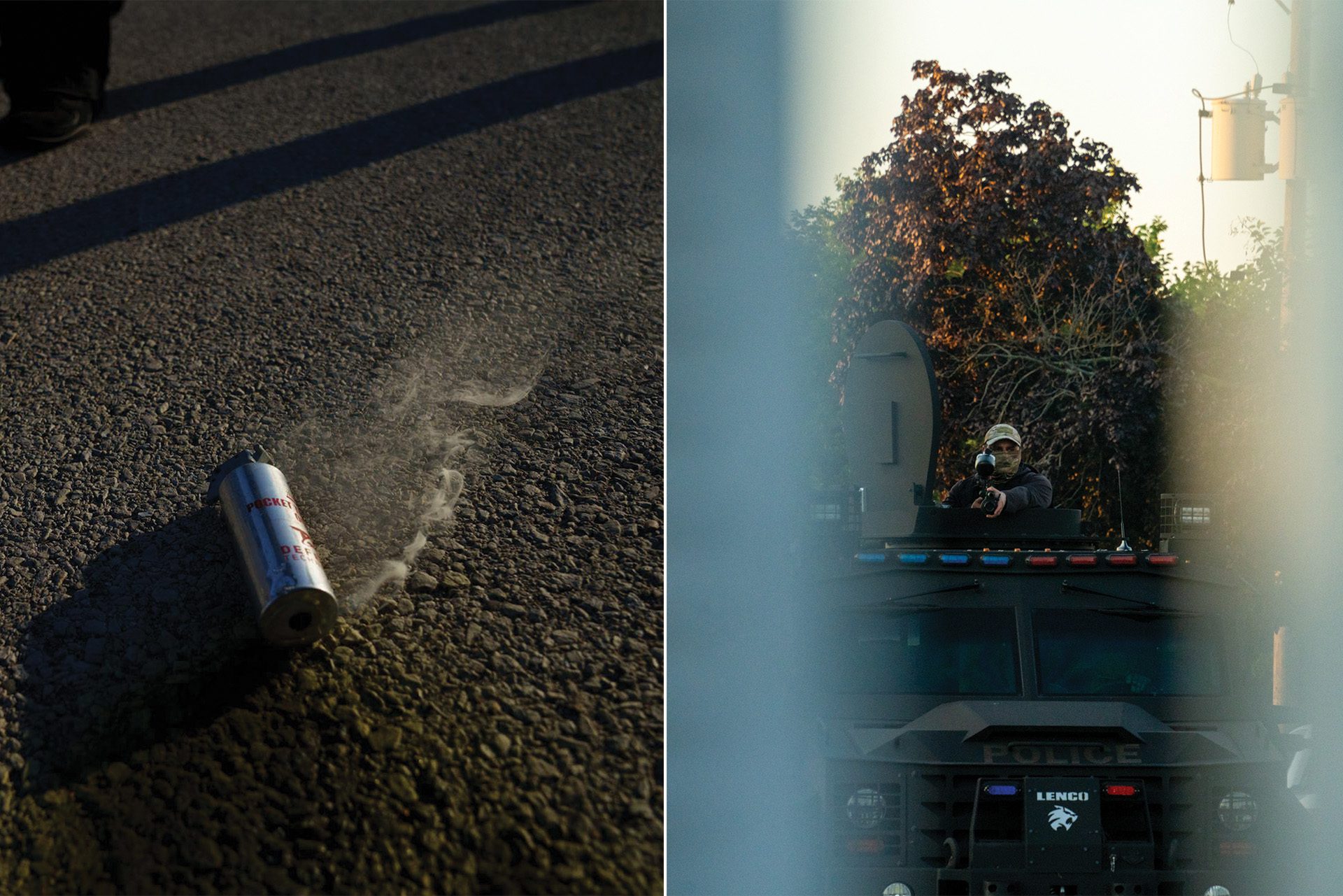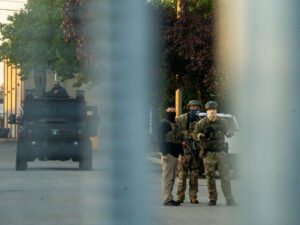 Daniel Powell/ZUMA Press Wire/Alamy and Camilla Forte/Borderless Magazine/Catchlight Local/Report for America
Daniel Powell/ZUMA Press Wire/Alamy and Camilla Forte/Borderless Magazine/Catchlight Local/Report for AmericaAmid frequent escalating protests and aggressive tactics by federal agents, Borderless compiled a guide to understand what substances agents are using — and how to stay protected in case of potential exposure.
Over the last month, President Donald Trump’s “Operation Midway Blitz” and his deployment of the Texas National Guard to Chicago have resulted in several instances of violence against protesters, elected officials and immigrant communities.
Federal agents have used aggressive tactics to target and detain street vendors, construction workers, officials and residents. In response, protests have erupted across the city, advocating against Immigration and Customs Enforcement (ICE) activity in Chicago. Reports say some agents have used tear gas and pepper balls on crowded streets and protests, a move that federal officials say is used to disperse crowds.
On Sept. 19, federal agents deployed tear gas, shot pepper spray bullets and flash-bang grenades at protesters outside the Broadview ICE facility. One CBS journalist reported having the side of her car hit with a pepper ball, leading to the chemicals engulfing the car and burning her face.
News that puts power under the spotlight and communities at the center.
Sign up for our free newsletter and get updates twice a week.
More recently, federal agents deployed tear gas into Chicago’s Southeast Side on Tuesday, during a confrontation between residents and immigration agents. A U.S. District Judge attempted to rein in officers’ use of chemical weapons in the Chicago area through a temporary restraining order.
Amid rising concerns of excessive use of force by federal agents and escalating confrontations, Borderless compiled a resource guide to help identify crowd control chemicals, when they are used, their effects and what to do if you encounter them.
What is tear gas?
Riot control agents, also known as tear gas, are chemicals that “irritate the eyes, mouth, throat, lungs and skin,” according to the U.S. Centers for Disease Control and Prevention (CDC).
Tear gas refers to different chemical agents used by law enforcement in crowd control.
Several different active compounds can be classified as tear gas, including:
- Chloroacetophenone(CN): a colorless, gray or white solid with a sharp, irritating smell that may appear as a blue-white cloud when released.
- Chlorobenzylidenemalononitrile(CS): a white or beige solid with a peppery odor that appears as a spray when dispersed.
- Chloropicrin(PS): a faint yellow oily liquid with an intense irritating odor that causes heavy eye irritation that is not heavily used today.
- Dibenzoxazepine(CR): a yellowish mist that is similar to CN and CS with a sharp odor.
Within seconds of exposure, riot control agents can cause irritation to the area of contact.
What is the main type of tear gas used during protests?
Depending on the police department, officers will most likely use tear gas with CN, CS or CR.
Agent CS is the most commonly used form of tear gas, and is typically dispersed by burning canisters or grenades, according to the Physicians for Human Rights.
When it’s released through the air, the powder will stick to any moisture it can find, from tears to sweat and grease on a person’s skin or eyes. It can have a choking effect, alongside a strong burning sensation in the individual’s lungs and throat.
Pepper spray, also known as Agent OC, provides more distance and accuracy and has been used by federal agents most recently to target protesters at the Broadview ICE facility.
What’s the difference between flash-bangs, tear gas and pepper spray?
Flash-bangs are devices deployed to stun and disorient people. They make loud noises and emit a bright flash of light when they explode. They can temporarily blind and deafen people nearby, and are used to disperse a crowd.
Tear gas and pepper spray differ in chemical makeup. The former can be made up of different chemical agents like CS or CN, while pepper spray uses the active ingredient OC, made up of the same compound that gives chili peppers their heat. Both substances can have similar effects of intense pain and burning in the eyes and skin.
While pepper spray is typically used to target people at close range, officers and agents have used pepper balls for longer distances. Pepper balls use the same irritant, but are fired from a launcher. Meanwhile, tear gas has historically been used to control a crowd and target a wider distance.
How can I know when chemical agents are being dispersed?
A key sign to prepare for chemical agents is when officers change crowd control strategies from containment to dispersal mode. Containment mode aims to restrict a crowd’s movement, while dispersal mode aims to break up the crowd and have them leave the area.
Officers that are preparing for dispersal mode will put on their gas masks or lower their visors, according to the International Women’s Media Foundation. They will also tighten in formation, creating a defensive line and raising their shields.
Read More of Our Coverage
Officers or agents may launch tear gas canisters, hand-thrown grenades or use riot guns.
They are required to warn crowds prior to dispensing tear gas to give them time to clear the area.
However, Border Patrol agents have continued to use tear gas to disperse crowds since.
What happens when I’m exposed to tear gas or pepper spray?
According to the CDC, someone’s level of poisoning depends on the amount, length of time and method of exposure to riot control agents.
People exposed to tear gas or pepper spray may experience some or all of the following symptoms after exposure:
- Excessive tearing and redness in the eyes
- Burning and blurred vision
- Rashes and irritation to the skin and mouth
- Trouble swallowing
- Running, burning and swelling nose
- Shortness of breath
- Wheezing and coughing
- Choking sensation
- Nausea and vomiting
Effects typically last 15 to 30 minutes after the individual is away from the source and cleaned off. Showing these signs and symptoms does not necessarily mean that a person has been exposed to tear gas.
What can I do if I’ve been exposed?
If you’ve been exposed to pepper spray or tear gas:
- Evacuate the area immediately and seek higher ground.
- Walk — don’t run.
- Flush the eyes with water for 10 to 15 minutes, and avoid touching the eyes, nose or mouth.
- Take a cold shower for at least 20 minutes to avoid irritation.
- Leave your shoes outside of your home.
- Hang your clothes in an open, ventilated area for at least 48 hours before washing.
- Seek medical care if your symptoms persist 30 minutes after decontaminating.
How can I stay protected?
If you’re attending a protest or area where these chemical substances may be dispersed, it would be useful to bring the following items:
- A facemask and eye protection
- Water in a plastic bottle with a squirt top (to wash off skin or eyes if needed)
- Identification and emergency contact information
- Inhaler, EpiPen and medications
- A change of clothes
For more information:
In case of experiencing a chemical emergency, contact all or one of the hotlines below.
For general guidance and information from the CDC:
- CDC hotline: 800-CDC-INFO
For expert advice on chemical exposure:
- Regional Poison Control Center: 1-800-222-1222
For general questions and additional information:
- Email inquiries: [email protected]
Tara Mobasher is Borderless Magazine’s newsletter writer and reporter. Email Tara at [email protected].


